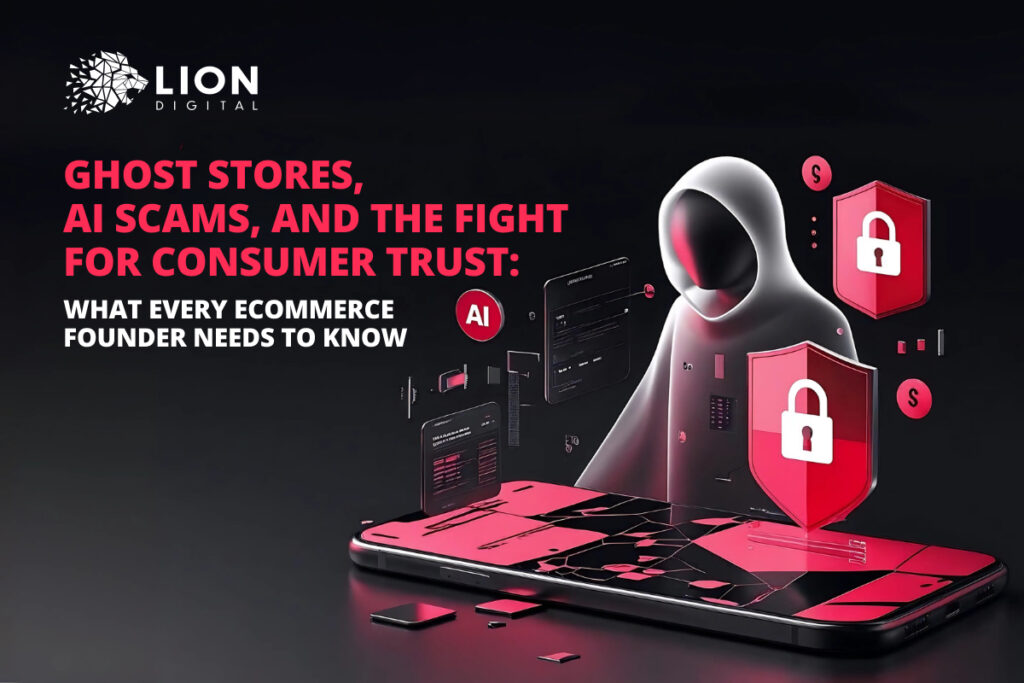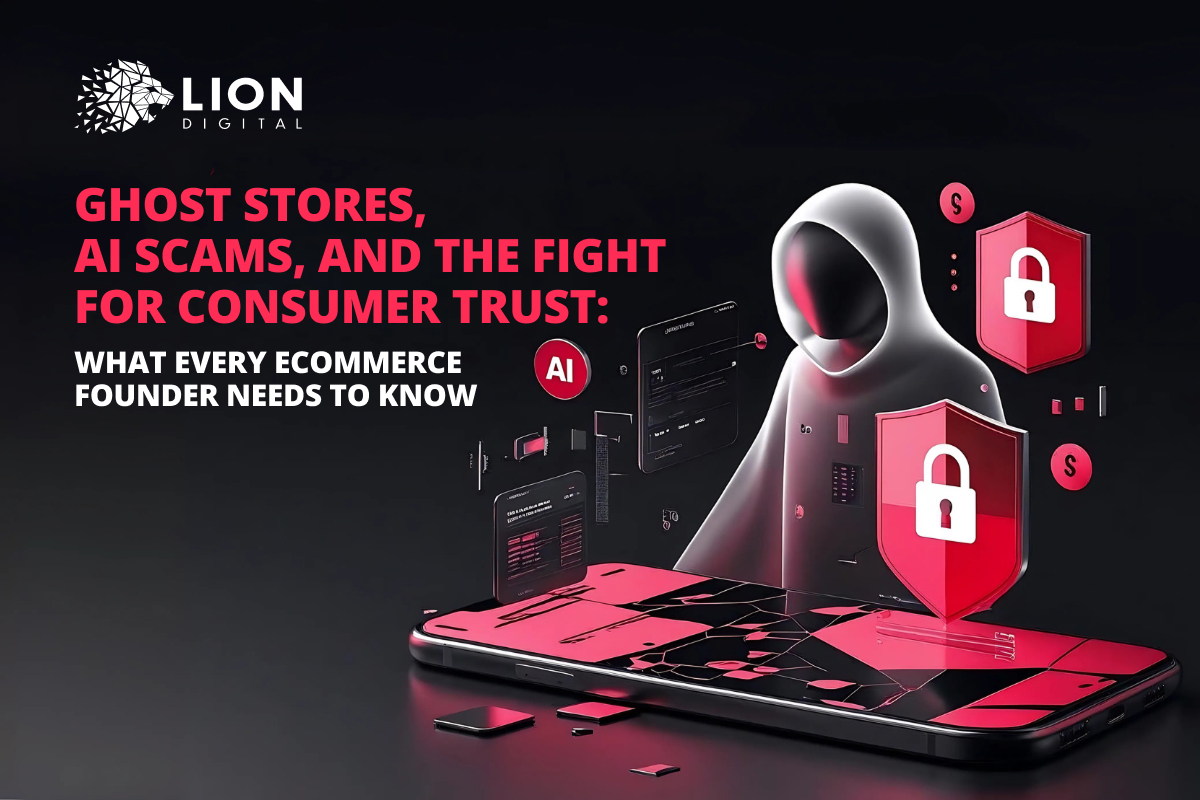
The online shopping industry is under attack, and it affects every eCommerce brand. Online ghost stores are popping up in Australia, fooling customers and damaging trust in legitimate businesses. You’re not just competing with other companies in your field anymore; you’re also fighting against fake online stores. They only exist digitally and have no real physical location or genuine business operations. Yet, they look very credible, so people can’t tell the difference, and that’s the problem.
When shoppers lose money to fake stores, they become suspicious of ALL online retailers. In other words, website scams damage consumers’ trust in eCommerce in general. If you’re running an online business, prepare for the new challenges. It’s becoming harder and more expensive for you to acquire new customers now.
ACCC Ghost Store Warning: Disturbing News for Every eCommerce Founder
Since early 2025, the Australian Competition and Consumer Commission (ACCC) has already identified more than 140 scam online clothing stores and received at least 360 reports about 60 different fake retailers. The real number is likely much higher, as many customers don’t report their bad experiences.
Scam websites use advanced AI technology to create fake product photos, fake customer reviews, and fake AI-written “about us” stories. They appear more professional and trustworthy than ever. Plus, they use popular ad platforms and sales strategies you may be using too.
Most online ghost stores work similarly: they pretend to be a local Australian store having a “closing down sale”. A customer sees an ad on Facebook or Instagram about this last sale, and the prices seem too good to pass up. People order products, expecting quality items from a local business. Instead, they receive cheap knock-offs shipped from China (if they receive anything at all).
Sadly, it’s not just a single case example. The ACCC has specifically warned about four scam sites: everly-melbourne.com, willowandgrace-adelaide.com, doublebayboutique.com, and sophie-claire.com. But there are many more other incidents, and each of them creates multiple sceptical customers who will now scrutinise your business more carefully before buying.
The Impact on Consumer Trust, Your Revenue, and Growth
Online ghost stores damage consumer trust in eCommerce as a whole. One person’s story about being scammed can influence dozens of their friends and followers to be vigilant about online shopping in general. The scepticism is understandable, but it makes running a legitimate business harder.
People start questioning every new eCommerce site and avoid shopping from unfamiliar brands, which means:
- Higher customer acquisition costs. You need more touchpoints and trust-building content to convert visitors into buyers.
- Lower conversion rates. Customers are doing more research, doubt every statement, and consider any inaccuracy as a red flag. It helps protect them from scams but also reduces your revenue as an online business.
- Increased return requests. Nervous customers are more likely to change their minds and ask for a refund.
- Expanded marketing budget. You now need to invest in trust-building activities that weren’t necessary before.
With ghost stores flooding the eCommerce industry, you now need to work harder to prove you’re not a scammer. It will be a challenge to gain new customers now, especially for small companies that people haven’t heard of before.
Market Changes That May Affect Your Operations
When customers lose money to fake stores, the reputation damage goes beyond individual businesses. People blame Facebook for running the ads, Shopify for hosting the site, and even Google for showing the store in search results. The ACCC also believes these platforms should take responsibility. The Commission sent a public warning to Meta and Shopify, urging them to investigate scam activity on their platforms and penalise the operators. That may be an effective strategy, but if Shopify implements stricter integration rules, it will likely affect legitimate businesses too. You might face:
- Longer approval times for new stores or ads
- Additional verification requirements
- Stricter content guidelines
- Higher barriers to entry for new businesses.
It’s already clear that scam sites are changing the game, and it will bring new challenges for eCommerce founders. You must keep up with industry news and what regulators are saying and regularly check that your website doesn’t have any red flags or signs of ghost stores.
Your Trust-Building Strategy Against Ghost Stores
The ghost stores challenge is also an opportunity for forward-thinking eCommerce founders. By being more transparent and customer-focused than ever before, you can build stronger relationships with customers who will become loyal advocates for your brand.
Here’s what you should do:
- Display your Australian Business Number (ABN) prominently on your website. Ghost stores rarely have valid ABNs because getting one requires a real business registration. Add your physical business address and provide multiple ways for customers to contact you: phone number, email, and online form. The more details you provide, the more real your store will look.
- Use local domain extensions. Most scam sites use .com domains while pretending to be Australian. That’s a red flag mentioned by ACCC. So if you’re a real Australian business, use a .com.au domain. Plus, it double-proofs that you’re a registered local business since .com.au domains require ABN verification.
- Share genuine content. Online ghost stores often use fake “about us” stories and pics generated by AI. You should show the real people behind the brand: post photos of your team, show your workspace, and add images of your products being made or packaged. Tell your real founder story: why you started the business, what challenges you faced—all in your own words (no AI content).
- Be transparent about everything. Clearly explain your return and refund policies. State your shipping fees and details. If you dropship some products, tell honestly about it and provide the info about origins. Ghost stores often hide these details, so your transparency will stand out.
- Show real customer experiences. Customer testimonials are more valuable than ever. But they are also easy to fake, so you should find a way to prove their authenticity. Feature real names and photos (with permission), and share unedited customer photos of your products in use. Consider creating video testimonials. Respond publicly to every review to show you’re actively engaged with customers. Scammers won’t communicate with customers; they can only fake written reviews and add AI-generated photos. Unlike legitimate businesses, scammers avoid direct communication with customers, relying instead on fabricated written reviews and AI-generated images.
- Invest in your social media presence consistently. Ghost stores often have brand new social media accounts with no history. Facebook, Instagram, and LinkedIn accounts can be your allies, your proof of authenticity. Regularly share behind-the-scenes content, engage with customers, and build a community around your brand. Don’t buy fake followers or reviews because savvy customers can spot them, and it will damage your credibility.
The main idea is to stay true to your values. Ghost stores might seem professional on the surface, but they can’t replicate the genuine care and transparency that your team provides. In essence, shoppers are looking for quality, consistency, and honesty, and LION Digital can help you become the brand people know and trust.
Our team will work with you to build an effective marketing strategy that differentiates your business from others (especially scammers) and helps you connect with customers authentically. With LION Digital by your side, you can easily navigate these ghost site challenges and grow with confidence.
FAQs
1. What are ghost stores, and how do they impact legitimate eCommerce businesses?
Ghost stores are fake online shops that pretend to be real Australian businesses but don’t actually exist. They claim to be closing down and advertise for “the last sale”, offering low prices. In reality, they are operated from overseas and either send cheap, low-quality products from China or take customers’ money and disappear completely.
The ghost stores problem affects customers’ trust and forces legitimate businesses to work twice as hard to prove they’re real. You have to spend more money on trust-building and compete in a market where customers are naturally suspicious of every online store. Plus, ghost sellers undercut legitimate businesses by offering their products at lower prices. You just can’t compete with their fake “closing down sale” prices because you have real business costs, but shoppers don’t know that and consider your products to be overpriced.
2. How can I protect my brand from being mistaken for a ghost store?
Display your ABN prominently, use a .com.au domain that requires ABN verification, add your physical address, and provide multiple contact methods – these are the absolute minimum. Consider also posting real photos of your team and workspace and sharing authentic founder stories. Additionally, your business can benefit from creating engaging social media accounts: post there regularly, and they will be your proof of credibility. Transparency in shipping, returns, and product sourcing is also essential.
3. What red flags should I look out for to detect ghost store impersonators or domain copycats?
Look for recently created domains, missing ABN numbers, no physical address, AI-generated photos, and a lack of searchable business registration. Monitor for domains using your brand name with different extensions, check for fake social media accounts, and watch for ads promoting unrealistic “closing down” sales using your products or similar branding. If you find some suspicious impersonators, report them to the ACCC.
4. How is AI being used to create fake eCommerce stores and reviews?
Generative AI is making fraud much easier to perform. The AI technology helps to create fake personalities and write fake reviews on their account. Ghost stores also use AI to create fake product photos, “about us” stories, and even fake team and warehouse photos, making scam sites appear more professional than ever.
5. What steps can I take to differentiate my store as a genuine, local brand?
Use authentic, unedited customer photos and video testimonials and showcase your real team and operations. You can post this behind-the-scenes content on your site or on social media. If you get any comments or reviews, respond to them publicly and be transparent about dropshipping if applicable. The more you engage directly with customers, the more credible your business looks because fake stores can’t replicate that customer care.
6. Should I include my ABN, physical address, and .com.au domain to build trust?
Absolutely yes. These are now essential trust signals that immediately differentiate you from ghost stores. ABN display proves business registration, .com.au domains require verification that scammers can’t obtain, and physical addresses show genuine local presence. These elements are not optional features anymore.
7. What are the reputational risks of ghost stores to the broader eCommerce industry?
Ghost stores destroy customers’ trust in all online businesses. It means higher return rates, longer sales cycles, and increased need for social proof across the entire industry. If you are just launching and haven’t gained loyal customers yet, acquiring new shoppers now is harder than ever. Additionally, because of the flood of ghost stores, the ACCC has written to Meta and Shopify asking to address the matter. This will likely result in stricter platform policies affecting all merchants.
8. How can I communicate authenticity effectively on my product pages and ads?
Include real customer photos using your products and feature real shoppers’ names and locations (with permission). Behind-the-scenes content is your best bet. Show actual product packaging and shipping processes and provide detailed product origins and manufacturing information. Avoid stock photos, and don’t use AI for content creation.
9. What legal or platform-level actions can I take if a ghost store mimics my brand?
Report to the ACCC Scamwatch at scamwatch.gov.au. You may also report trademark infringement to hosting platforms, report fake ads to advertising platforms, and consider legal action for trademark violation. Document all evidence of copying your brand elements and send them to the authorities.
10. How do I leverage customer reviews and social proof to rebuild consumer trust post-scam exposure?
Focus on video testimonials that are harder to fake, and encourage customers to post unedited photos with your products. Your team should also respond personally to every review to maintain engagement and build trust. Consider creating user-generated content campaigns and sharing customer success stories with real names and faces or links to their social accounts (ask for permission first). Don’t buy reviews or bot subscribers. Customers are becoming more vigilant now, so they will find out, and it can harm your reputation.






